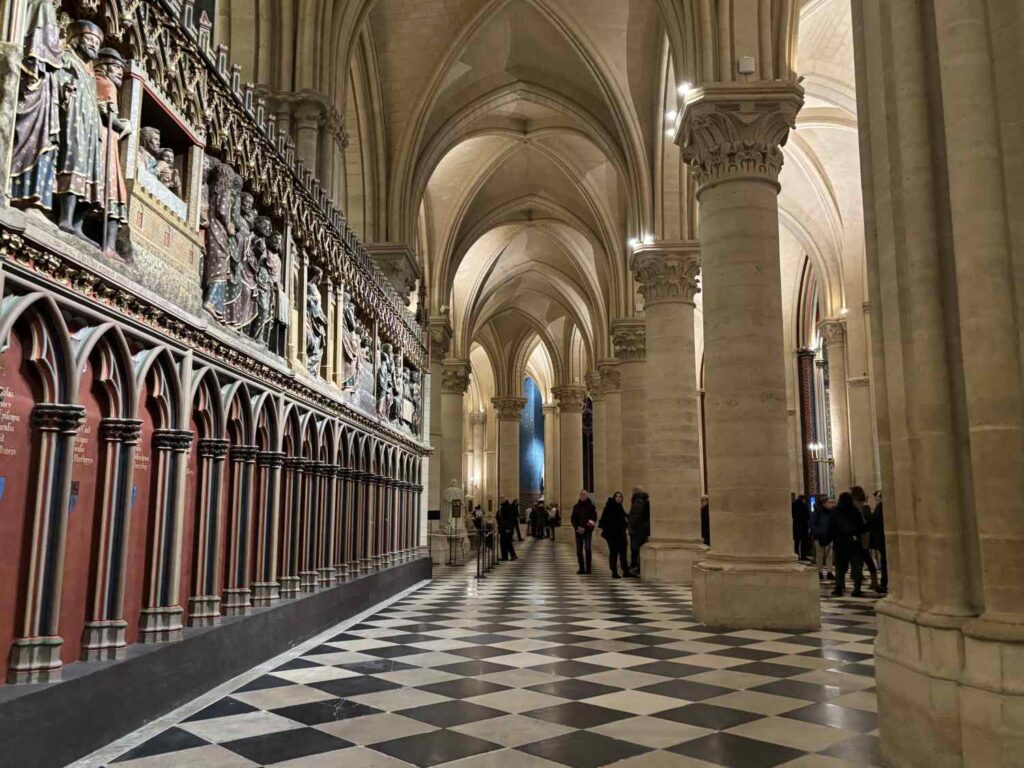After five years of meticulous restoration, Notre Dame Cathedral officially reopened in December 2024. The return of this iconic Gothic masterpiece was a landmark moment, celebrating the remarkable effort to restore one of history’s most treasured architectural wonders. I was fortunate to go inside Notre Dame Cathedral during its first week of reopening, a time filled with special celebrations, including evening public Mass services and cultural events that brought the cathedral’s renewed grandeur to life. It was an unforgettable experience, marked by a profound sense of history and celebration. So much work has gone into its restoration that the cathedral looks almost brand new.
Here’s a quick guide to the cathedral, the fire, the restoration efforts, and tips on how to plan your visit.

Brief History of the Notre Dame Cathedral
The history of Notre Dame Cathedral is deeply tied to France’s story, reflecting its cultural, spiritual, and political evolution. Construction began in 1163 under Bishop Maurice de Sully, with the foundation stone reportedly laid in the presence of King Louis VII and Pope Alexander III. The cathedral’s construction continued for nearly 200 years, concluding around 1345. It became one of the finest examples of French Gothic architecture, known for its flying buttresses, intricate sculptures, and stunning rose windows.
Notre Dame is also the guardian of one of Christianity’s most revered relics: the Crown of Thorns, believed to have been placed on the head of Jesus during his crucifixion. The relic was brought to Paris by King Louis IX (later Saint Louis) in 1239 and housed in the Sainte-Chapelle before being transferred to Notre Dame.
Notre Dame has witnessed key moments in French history, including the coronation of Henry VI of England in 1431 during the Hundred Years’ War and Napoleon Bonaparte’s self-coronation in 1804. During the French Revolution, the cathedral suffered significant damage—its treasures were looted, statues were decapitated, and it was converted into a Temple of Reason (a state atheist temple). By the 19th century, the cathedral had fallen into disrepair, but Victor Hugo’s 1831 novel The Hunchback of Notre-Dame renewed public interest, leading to a major restoration project in 1844 led by Eugène Viollet-le-Duc. It was during this restoration that the iconic spire, later lost in the 2019 fire, was added.
The 2019 Fire: What Happened to the Notre Dame Cathedral?
On the evening of 15 April, 2019, a devastating fire broke out beneath the roof of Notre Dame Cathedral, rapidly engulfing the centuries-old structure. The blaze spread with alarming speed, fueled by the cathedral’s wooden framework, often referred to as “the forest” due to its construction from hundreds of oak beams dating back to the 12th and 13th centuries. Within hours, the iconic spire, designed by Eugène Viollet-le-Duc in the 19th century, collapsed, and large portions of the roof were destroyed. The fire also caused significant damage to the upper walls, compromising the stability of the stone structure.
Thankfully, the cathedral’s main bell towers, façade, and many priceless artifacts, including the Crown of Thorns and several relics, were saved through the heroic efforts of firefighters and emergency crews. The organ and many interior artworks inside Notre Dame also survived, although they required extensive cleaning and restoration. The cause of the fire remains inconclusive, but investigators suggested it may have been linked to electrical wiring or construction work being carried out for routine maintenance.
The event prompted an outpouring of global support, with nearly €1 billion in donations pledged to restore the cathedral to its former glory.

What Has Changed at the Notre-Dame Cathedral
The restoration of Notre Dame Cathedral after the 2019 fire was one of the most complex and ambitious repair projects in modern history. Here are the key features of the repair work and how they were accomplished:
The Rebuilt Spire
The iconic 93-meter spire, originally designed by Eugène Viollet-le-Duc in the 19th century, was completely destroyed in the fire. It has been reconstructed using the same materials and techniques as the original. Oak wood from French forests was used for the spire’s framework, while lead was applied to replicate its original appearance. The spire was hoisted into position using the largest crane in Europe, after which a scaffolding framework was installed to enable workers to construct the structure as it gradually took shape.
Major Cleaning
The standout feature of the renovated cathedral is the brightness of the stonework inside Notre Dame. This was achieved by thoroughly cleaning the limestone blocks, with damaged sections replaced using limestone sourced from the same quarries in northern France that supplied the original stones in the 12th century.
Notre Dame’s iconic stained-glass windows, including the world-famous rose windows, survived the fire but suffered damage from smoke and heat. These windows were carefully removed, cleaned, and restored by expert glassmakers, returning them to their original vibrancy.
Rebuilding the Timber Framework
The medieval roof framework, known as “The Forest,” was completely destroyed in the fire. Experts used historical records and 3D modeling to reconstruct the intricate design inside Notre Dame. More than 1,000 oak trees, harvested from across France, were carefully shaped into beams using medieval carpentry methods, faithfully replicating the original craftsmanship.
Preservation of the Grand Organ
The cathedral’s grand organ, one of the largest in the world with 8,000 pipes, was spared from the flames but covered in soot. Specialists dismantled each pipe, cleaned and restored them, and reassembled the organ. It was then recalibrated to ensure it produces its signature rich and resonant sound.

Ongoing Restoration Work
Despite the successful reopening of Notre Dame Cathedral in December 2024, restoration efforts are still ongoing. Scaffolding remains in place around parts of the eastern end, particularly near the apse and sacristy, where the exterior walls require further treatment. This phase of the restoration is expected to continue through 2025 and beyond.
Additionally, there are plans to redesign the esplanade surrounding the cathedral to enhance the visitor experience and integrate green spaces into the urban environment. This redevelopment is scheduled to begin in 2025, with completion targeted for 2030.
Furthermore, there are proposals to create a museum dedicated to the history and artifacts of Notre Dame in the neighboring Hôtel-Dieu hospital. This initiative aims to provide deeper insights into the cathedral’s cultural and religious significance, though the timeline for this project has not yet been finalized.
Visiting the Re-Opened Notre Dame Cathedral

As of 10 December, 2024, Notre Dame Cathedral is open to the public for both worship and tourism. Access to the cathedral is free of charge every day during its opening hours, and reservations are not mandatory.
Booking Your Visit
While reservations are not mandatory, it is highly recommended to reserve a time slot a day or two in advance, or even on the day of your visit. Without a reservation, you can still enter, but you may face longer wait times, especially during busy periods. New time slots are added regularly, so it’s a good idea to check the website frequently for updated availability.
To reserve your free ticket, visit the official website or a dedicated mobile app of Notre-Dame de Paris. Use the interactive reservation portal to select a time slot from the available options, and your digital ticket will be sent to you by email.
Opening Hours
- Monday to Friday: 7:45am – 7pm
*closing on Thursday at 10pm
- Saturday and Sunday: 8:15am – 7:30pm
Last entry 30 minutes before closing.
Concerts
In addition to regular visits, the cathedral will host musical concerts. Tickets for these events can be booked through the Sacred Music at Notre-Dame de Paris website.
How to Get Here
Notre Dame Cathedral is located on Île de la Cité, a small island in the Seine River at the heart of Paris.
By Metro:
- The nearest metro stations are Cité (Line 4) and Saint-Michel (Line 4). Both are a short walk from the cathedral.
- Alternatively, you can use Hôtel de Ville (Lines 1 and 11) or Châtelet (Lines 7, 11, 14), which are slightly further but still within walking distance.
By RER:
- The closest RER station is Saint-Michel–Notre-Dame (RER Lines B and C), located just across the Seine. From there, it’s a 5-minute walk to the cathedral.
Making Use of the Guides and the Mobile App
The cathedral is large, and I would advise to allow approximately 45 minutes to explore inside Notre Dame. An illustrated Visitor Guide is available for purchase at the front desk for €10. Offered in multiple languages, it highlights key aspects of Notre Dame’s history and architecture. For those wishing to pray at the cathedral, a Pilgrim Guide is available for €5.
The official mobile app offers several tours in French, English, and Spanish, which you can download and follow as you visit the cathedral. There is a choice of:
- “Visit the Cathedral” – a general guided tour lasting approximately 35 minutes.
- “Visit as a Pilgrim” – a spiritual tour lasting about 45 minutes.
- “Visit with Family” – a guided tour for young visitors, lasting around 25 minutes.
There is also a gift shop selling Notre Dame memorabilia, books, and other items.
I highly recommend visiting the cathedral in Paris now that it has reopened. If you were fortunate enough to see it before the fire, you’ll be amazed at how much has changed inside Notre Dame, from the restored stonework to the vibrant stained-glass windows. And if you’ve never visited before, this is the perfect opportunity to experience one of the world’s most iconic landmarks in its renewed splendor. Whether it’s your first visit or a return, Notre Dame is truly a must-see.
Have you visited the reopened Notre Dame Cathedral yet or want to go? Share in the comments below and join me on Instagram to get more inspiration for things to do in Paris.
If you’re looking for Paris itineraries with kids, then check out my free Paris Itineraries with Kids, especially this itinerary here that includes activities to do near the Notre Dame Cathedral and on the Île de la Cité. My Ultimate Guide to Paris with Kids is also packed with family-friendly tips and recommendations on things to see and do in Paris.
Disclosure: This post contains affiliate links and I receive a commission if you visit a link and buy something on my recommendation. Purchasing via an affiliate link doesn’t cost you any extra, and I only recommend products and services I trust.



